Permeability of Super Therm in Australian Buildings
Passive House standards and building performance optimisation is vital in Australia…as it should be around the world. In Canberra we are working with our current Applicator/Dealer testing Super Therm on a Canberra home in Rivett, ACT. This residential home is concrete tiles. At the same time we have are recording temperatures inside, outside and humidity of the Super Therm home and the control home. The preliminary results are promising.
Super Therm’s permeability rating of 8.8 US Perms, equivalent to 457 µg/N.s.
Perm Rating (ASTM D1653-13): 250 microns/0.25mm = 8.8 perms; 300 microns/0.30mm = 4 perms
While residential applications are typically a core focus for Super Therm‘s benefits, this collaboration with a specialist Passive House builder and his plans for a high-performance, self-built home underscores the relevance. His comprehensive research and testing with Super Therm have highlighted its thermal insulation, acoustic dampening, fire and importantly its vapour permeability were outstanding.
After comparing perm data (and more) from NEOtech Coatings and SPI Coatings (manufacturer) and relevant standards, Super Therm’s has a permeability rating of 8.8 US Perms, equivalent to 457 µg/N.s. Rating much higher for permeable materials than the minimum required for Class 4 materials.
The National Construction Code (NCC) of Australia, Class 4 materials refer to materials used in construction that are highly vapour-permeable. This classification is typically applied to products like house wraps or wall membranes, which allow moisture vapour to pass through but prevent bulk water from entering. Class 4 materials play a crucial role in ventilated building envelopes, as they help manage moisture levels within walls, reduce the risk of condensation build-up, and thereby prevent issues like mould growth.
Class 4 materials are designed to achieve high breathability, which enhances indoor air quality and ensures structural longevity by allowing moisture to escape from within the wall cavity while still providing a barrier against air infiltration. This feature is essential for Passive House and other high-performance building standards, especially in Australia’s varying climates. Super Therm’s permeability rating of 8 US Perms makes it well-suited for these applications, aligning with the criteria for Class 4 under the NCC.
Extensive testing of Super Therm
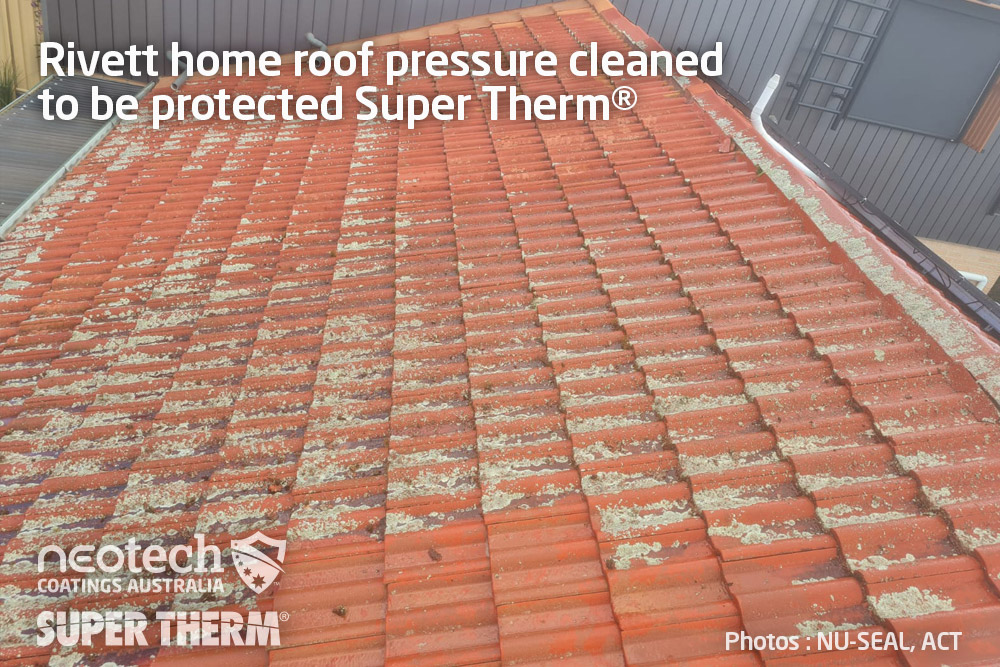
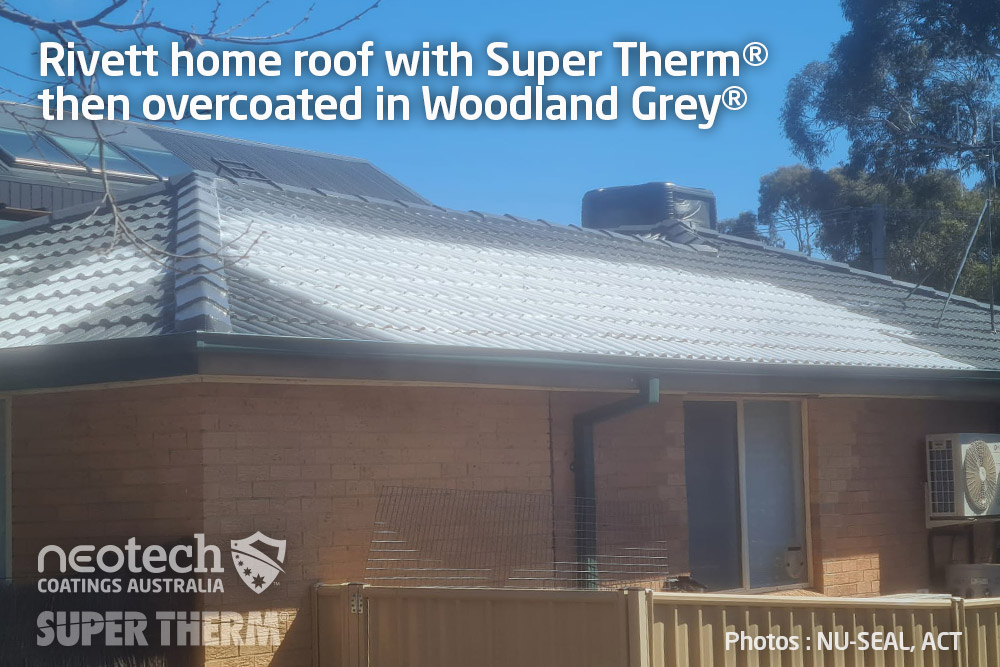
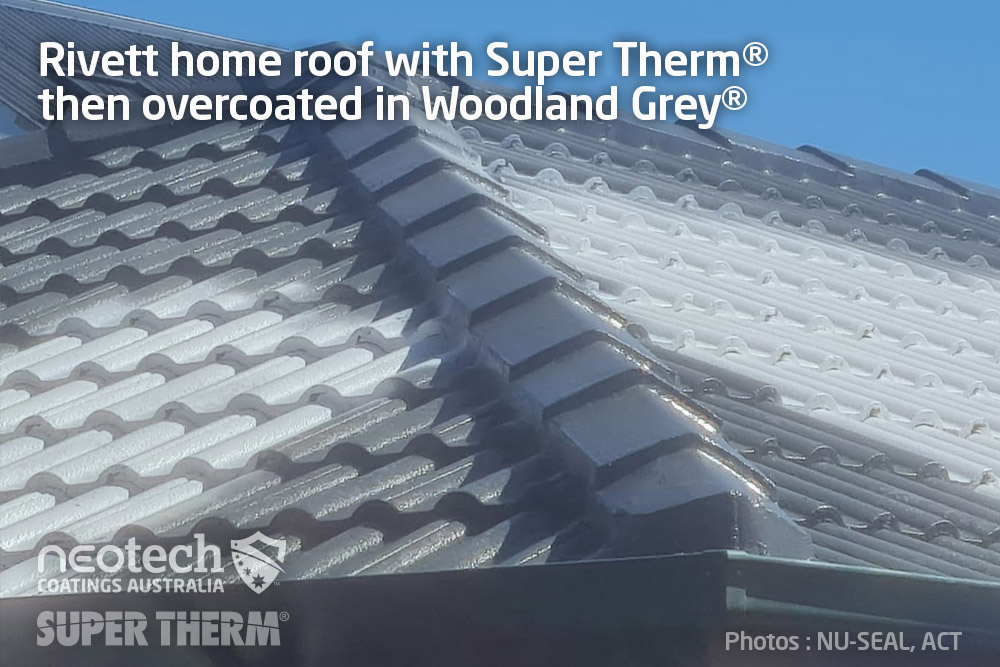
CANBERRA – Rivett, ACT Super Therm home pilot
Since August 2023, our team at Nu-Seal Roof Restoration and Painting, ACT, have been collecting data that demonstrates the overwhelming benefits of a Super Therm® Thermal Insulation Coating on a concrete tiled roof, with both heat retention and heat blocking benefits. This is particularly significant in Canberra, where extreme temperature variations within a 24-hour period can be common.
The Super Therm® coating has been overpainted over with Woodland Grey® at the customer’s request, which does diminish its full effect to blocking visual spectrum of solar heat with Super Therm. The roof still produces a substantial positive benefit blocking the infrared, conductive heat on temperature reduction in summer and encapsulation of heat in winter as it performs like a membrane reducing warm air flow and humidity.
The client, Peter, has an engineering background was very impressed with Super Therm‘s performance after all his research. Peter has access to all the live data and has conducted his own analysis, confirming the coatings effectiveness for the well being of himself and his family.
Warmer months Performance
We have observed a steady increase in the temperature differential between the roofs as the days become warmer (Graph 2). Currently, there is a 12-14°C difference (October 2023) between the peak temperatures, compared to 8-10°C in June (Graph 3). This gap is expected to widen with higher temperatures and consecutive hot days.
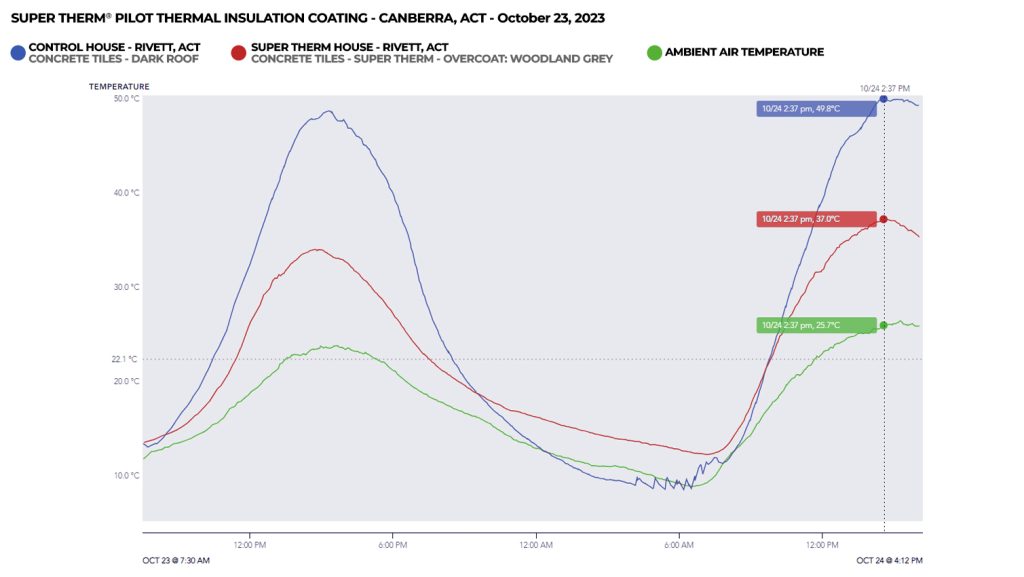
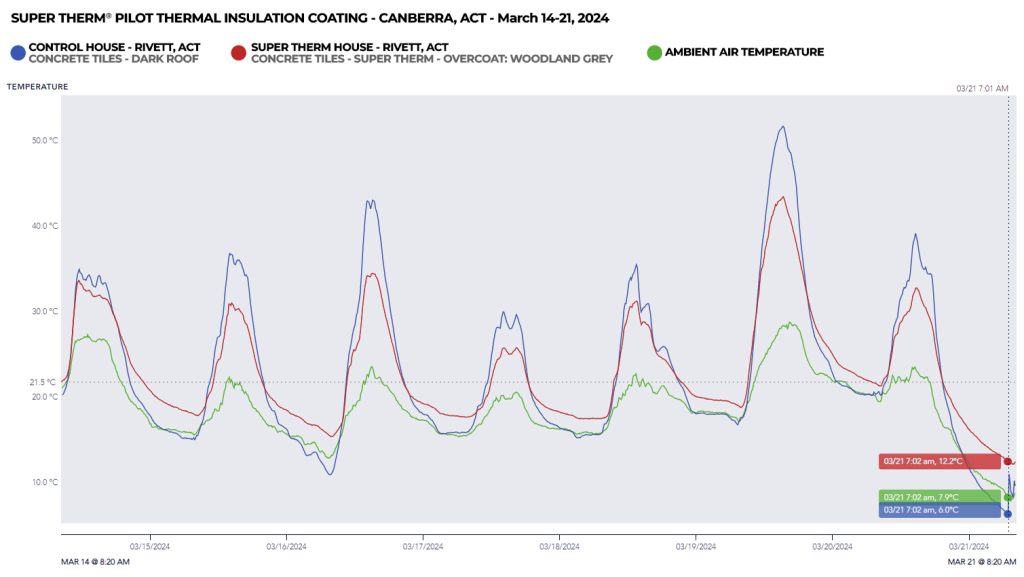
Cooler Months Performance
Despite the colder nights, Peter has noticed that since the application of Super Therm® in August 2023, his heater has not activated overnight. This has resulted in two months of no overnight heating, leading to cost savings and carbon reduction and a healthier home. The graph below illustrates a typical overnight scenario: the dark blue line representing the “Original Roof” falls below the outside ambient temperature each night. Meanwhile Peter’s Super Therm® roof stays above ambient.
The jagged part of the dark blue line indicates when the ducted gas heating activated at 4am and ran until 7:30am in the control house. Even with the ducted heating for 3.5 hours, it’s insufficient to raise the neighbour’s roof temperature and regulate the humidity. Peter used no heating. This cycle repeats, keeping Peter’s roof thermally protected. The roof (future walls) have stabilised with the environment.
This is an ongoing 20 month trial where we will collect data from 2 summers and 2 winters.
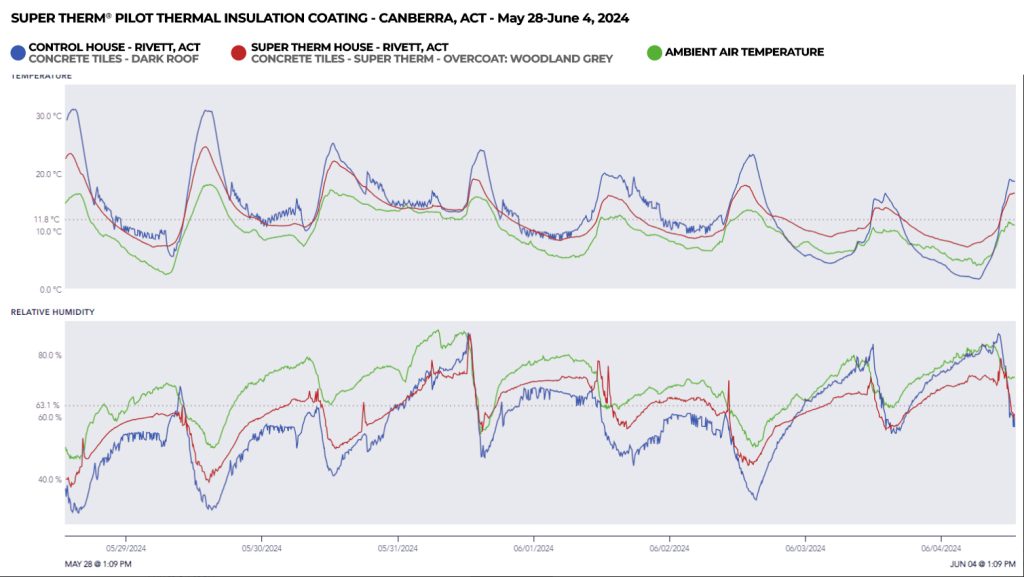
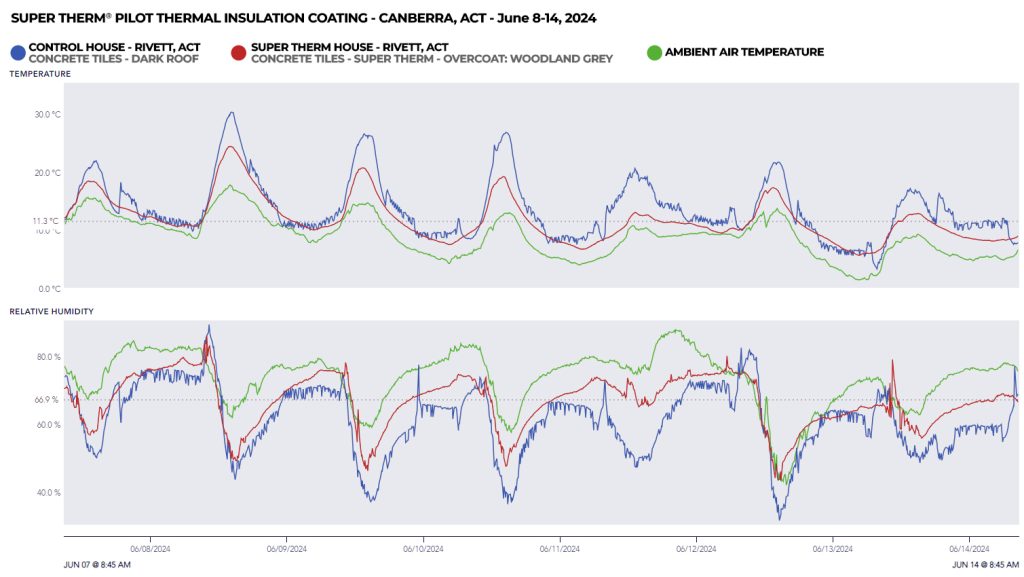
- Data Collection and Initial Observations
- Since August 2023, data shows Super Therm’s effectiveness in both heat blocking and heat retention.
- This dual effect is particularly valuable in Canberra’s climate, where extreme temperature swings within 24 hours are common.
- Note: The Super Therm coating was painted over with Woodland Grey at the customer’s request, slightly reducing its full impact, yet still yielding significant results.
- Customer Satisfaction and Analysis
- The customers, especially Peter, are pleased with the performance and are conducting their own analysis based on the data, showing a strong understanding and appreciation of the product’s benefits.
- Increasing Temperature Differences
- As daily temperatures rise, there’s a noticeable increase in the difference between the insulated and non-insulated roof temperatures.
- Current data indicates a 12-14°C difference in peak temperatures, up from 8-10°C a month ago, with expectations of a wider gap as summer progresses.
- Nighttime Heat Retention and Energy Savings
- Since applying Super Therm in August, Peter’s heater has not needed to switch on overnight even once, providing immediate energy savings.
- Data comparison shows the original tiles fall below the ambient temperature each night, triggering the heating system at 4 a.m. and running for 3.5 hours until 7:30 a.m.
- Despite 3.5 hours of heating, the neighbour’s roof temperature still remains below Peter’s, even without any overnight heating in Peter’s home.
- Daily Temperature Cycle
- Peter’s roof not only retains heat better overnight but also remains cooler during the day compared to the neighbouring roof, showcasing Super Therm’s insulation advantage across a full daily temperature cycle.
This highlights Super Therm’s dual benefits in managing temperature fluctuations, delivering energy savings, and maintaining a comfortable indoor climate in extreme conditions in the ACT environment.
Super Therm benefits over current vapour solutions
Super Therm offers many advantages over standard wraps and vapour barriers, making it a superior choice in high-performance and sustainable building applications. Here’s a breakdown of its key differentiators:
1. Advanced Thermal Insulation
- Multi-Ceramic Technology: Super Therm uses multi-ceramic compounds that block up to 96.1% of solar heat, unlike standard wraps which only offer basic radiant or thermal resistance. This multi-layer technology provides superior solar reflection and heat blocking insulation, reducing the reliance on HVAC systems and creating energy-efficient buildings.
- Thermal Break in Thin Layers: Its thin coating acts as a powerful thermal break with a significantly lower thickness than traditional insulation, providing more usable interior space and reducing material requirements without sacrificing performance.
2. Fire Resistance
- High Fire Rating: Super Therm has excellent fire resistance and has been rigorously tested to withstand high temperatures without degradation. It not only protects surfaces but also limits the spread of fire. Standard wraps and barriers often rely on non-flammable additives but may fail under high heat, whereas Super Therm’s ceramic formulation is inherently resistant.
- Building Code Compliance: Its fire performance can meet or exceed building code standards, providing a strong case for its use in structures where fire safety is paramount, especially in bushfire-prone areas of Australia.
- Super Therm® Fire Testing: Blocks Flame Spread and Smoke – Class “A” Fire Rating “0” Flame Spread and Smoke – tested by:
- NASA – NHB 8060.1C
- FM Approvals – ASTM E108
- ABS Fire Resistive Rating – IMO FTP Code, 2010
- Australian AWTA Fire Testing – AS/NZS 1530.3
- Omega Point Labs – ASTM E84 – Limits the spread of fire – 0 Flame Spread and 0 Smoke Developed
3. Acoustic Insulation
- Sound Dampening Properties: Super Therm has been tested to reduce sound transmission by up to 68%, making it far more effective at noise control than conventional vapour barriers or wraps, which typically don’t address acoustics. This benefit is particularly valuable in urban or industrial settings where soundproofing is essential for occupant comfort.
4. Superior Vapour Permeability
- Controlled Breathability: Unlike standard vapour barriers that may restrict airflow entirely or provide minimal permeability, Super Therm’s vapour permeability rating of 8.8 US Perms (457 µg/N.s) allows for effective moisture escape without compromising thermal performance. This reduces condensation risks, preventing mould and structural degradation over time.
- Moisture Management for Longevity: Super Therm’s ability to breathe while blocking moisture improves durability by protecting structural elements from corrosion or decay, an essential advantage over wraps that may trap moisture and lead to internal damage.
5. Long-Lasting Durability
- UV and Weather Resistance: Super Therm’s ceramic coating is formulated to resist UV radiation and weathering over time, maintaining its protective qualities and performance. Traditional wraps can degrade with prolonged sun exposure, whereas Super Therm offers a long-lasting, durable solution that reduces maintenance costs for over 20 years.
- Performance Stability Over Time: Its multi-ceramic formula doesn’t degrade or lose effectiveness with age, making it a cost-effective choice for projects needing consistent insulation performance across decades, compared to traditional wraps that may need frequent replacements.
6. Environmental and Sustainability Benefits
- Reduced Energy Consumption: By blocking a significant portion of solar heat, Super Therm reduces the need for air conditioning, directly lowering energy consumption and greenhouse gas emissions, aligning with sustainability goals and carbon reduction targets.
- Non-Toxic and Eco-Friendly: Unlike some traditional wraps, Super Therm is a low-VOC, non-toxic product, which is essential for sustainable and eco-conscious building practices.
7. Flexibility in Application
- Versatile Use Cases: Super Therm can be applied to a variety of substrates and structures, from walls and roofs to industrial tanks and pipelines, making it an adaptable solution across diverse building and industrial projects.
- Air and Vapour Barrier Combination Potential: Super Therm can function as both an air and vapour barrier with high permeability, simplifying installation processes by potentially reducing the need for multiple layers, which traditional wraps or barriers often require.
Super Therm’s blend of thermal, acoustic, and moisture-control properties, combined with fire resistance, durability, and eco-friendly credentials, makes it a robust, multi-functional solution that far outperforms conventional vapour barriers and wraps in both commercial and residential applications.
If you’re genuinely interested in permeable barriers, Super Therm® is not just a moisture barrier but a water barrier (not a waterproof membrane), designed to block any moisture from humid air or rain from reaching surfaces, preventing corrosion. With a permeability of 8.8, Super Therm® allows airflow without moisture penetration. This statement aligns perfectly with the goals for Passive House design.
While Super Therm doesn’t provide R-value ratings because is a closed cell insulation, this research is worth pursuing for its potential in Passive House and high-performance buildings. Fire resistance is another notable advantage that Super Therm brings, along with durability that outperforms traditional insulation.
The growing interest in sustainable building materials in Australia makes Super Therm well-positioned to fill a unique niche and if matched with the right architects and builders will simply amazing you. As an effective thermal and breathable wrap and other core functionalities, Super Therm will redefine building envelope performance and create a strong business case for its adoption in new construction methods.









